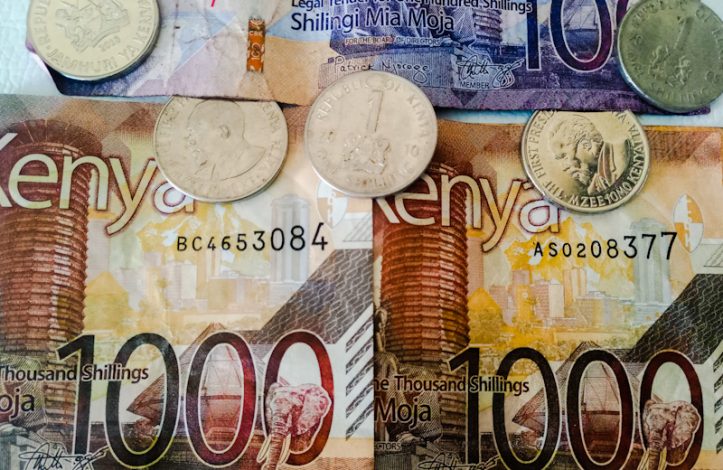The Kenyan shilling hit a record low of 150 against the dollar on Monday.
Last week, the Kenyan shilling depreciated against the US dollar by 0.4% to close at Kshs 149.8, from Kshs 149.1.
“On a year-to-date basis, the shilling has depreciated by 21.4% against the dollar, adding to the 9.0% depreciation recorded in 2022. We expect the shilling to remain under pressure in 2023,” according to Cytonn Investments.
High debt levels and dwindling government revenues have driven the depreciation of the shilling.
Central Bank of Kenya data indicates that the dollar is trading slightly over 150 shillings.
Commercial Bank Rates for Currencies 23 October 2023
| CURRENCY | MEAN | BUY | SELL | |||
| US DOLLAR | 150.0735 | 149.9735 | 150.1735 | |||
| STG POUND | 182.5409 | 182.3959 | 182.6859 | |||
| EURO | 159.0944 | 158.9588 | 159.2300 | |||
| SA RAND | 7.9532 | 7.9465 | 7.9599 | |||
| KES / USHS | 25.0211 | 24.9711 | 25.0711 | |||
| KES / TSHS | 16.6652 | 16.6208 | 16.7096 | |||
| KES / RWF | 8.1492 | 8.0872 | 8.2113 | |||
| KES / BIF | 18.9147 | 18.7988 | 19.0306 | |||
| AE DIRHAM | 40.8597 | 40.8269 | 40.8925 | |||
| CAN $ | 109.7590 | 109.6699 | 76.8302 | 109.8482 | ||
| S FRANC | 168.5084 | 168.3583 | 168.6585 | |||
| JPY (100) | 100.2730 | 100.2028 | 100.3431 | |||
| SW KRONER | 13.7016 | 13.6907 | 13.7125 | |||
| NOR KRONER | 13.5741 | 13.5622 | 13.5861 | |||
| DAN KRONER | 21.4823 | 21.4671 | 21.4976 | |||
| IND RUPEE | 1.8072 | 1.8059 | 1.8086 | |||
| HONGKONG DOLLAR | 19.1853 | 19.1726 | 19.1981 | |||
| SINGAPORE DOLLAR | 109.9641 | 109.8868 | 110.0414 | |||
| SAUDI RIYAL | 40.0068 | 39.9780 | 40.0356 | |||
| CHINESE YUAN | 20.5535 | 20.5381 | 20.5689 | |||
| AUSTRALIAN $ | 95.4768 | 95.3982 | 95.5554 | |||
|
SOURCE: COMMERCIAL BANKS
|
||||||
The Kenyan shilling, despite recent depreciation, is expected to find support from two key factors:
- Diaspora Remittances: As of September 2023, diaspora remittances stood at a cumulative USD 3,106.7 million, marking a 3.8% increase from the USD 2,992.5 million recorded over the same period in 2022. This steady flow of remittances has played a crucial role in cushioning the shilling against further depreciation.
- Tourism Inflow Receipts: The tourism sector also provided substantial support, with inflow receipts reaching USD 268.1 billion in 2022. This represents an 82.9% increase from the USD 146.5 billion recorded in 2021.
Kenya Shilling Exchange Rate Overvalued
Kenya’s Central Bank Governor, Dr. Kamau Thugge, has admitted that the Kenya Shilling’s exchange rate against the US dollar and other hard currencies has been artificially high, putting significant strain on the country’s foreign exchange reserves.
According to the CBK Governor, the overvaluation of the Shilling became evident in 2022 when major central banks in Europe and the US began tightening their monetary policies, leading to capital outflows from Kenya and other less developed economies.
As a result, Kenya’s foreign exchange reserves dipped from 5.5 to 3.7 months of cover, falling below the CBK’s statutory requirement of at least 4 months of import cover.
“For several years, the Kenyan economy has had an overvalued exchange rate. Some 5 or 6 years ago, the IMF and the World Bank argued that the Kenya Shilling exchange rate was overvalued by anything between 20.0% and 25%,” said Governor Dr Kamau Thugge.
“Kenya tried to maintain a “fairly artificially strong” exchange rate at the cost of loss of its foreign exchange reserves, leading to a dip in reserves from 5.5 to 3.7 months of cover, “said Dr. Thugge.
Charlie Robertson, head of macro-strategy at FIM Partners, says it was Kenya’s external borrowing that kept the shilling strong.
“Agreed with all of this, and I’d add that it was external borrowing which kept the Kenya shilling strong. The rise in external debt each year was similar to the size of the current account deficit. This allowed the KES to remain stable when inflation implied it should weaken.”
Agreed with all of this and I’d add that it was external borrowing which kept the Kenya shilling strong. The rise in external debt each year was similar to the size of the current account deficit. This allowed the KES to remain stable when inflation implied it should weaken https://t.co/EStj1ytA8y
— Charlie Robertson (@CharlieTTEcon) October 24, 2023




